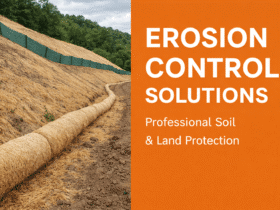Key Takeaways
- Minor changes to lawn care habits can substantially reduce water consumption and keep harmful chemicals out of local waterways.
- Choosing the right grasses, embracing organics, and growing various plants keep your yard beautiful while making it easier to care for.
- Mindful lawn practices support pollinators, birds, and healthy soil while supporting local climate resilience.
- Anyone can adopt sustainable approaches, regardless of yard size or climate; even small steps can make a real difference.
Why Sustainable Lawns Matter
Lawns cover an estimated 40 million acres in the United States alone, making them the most widely grown “crop” in the country. While a lush green lawn may be a source of pride and curb appeal, how we maintain these grassy spaces makes a crucial difference in environmental health. Watering habits, chemical applications, and plant choices impact local water supplies, pollinators, and wildlife downstream. Sustainable lawn care aims to minimize negative impacts, support nature, and even enhance the overall look of your landscape. The good news is that you don’t have to sacrifice appearance for environmental stewardship. Expert groups and services are increasingly integrating eco-friendly solutions, such as those available through Hayward lawn care services. These initiatives are helping homeowners rethink their yards as more than displays but as essential contributors to neighborhood resilience. Simple tweaks in water, mowing, planting, and feeding can lead to a healthier yard and community. From switching to drought-tolerant grass species to leaving grass clippings on the lawn as natural mulch, small changes can yield enormous ecological benefits. Reducing or eliminating synthetic fertilizers and pesticides protects local waterways and fosters a thriving soil ecosystem beneath your feet. As awareness grows, more homeowners are embracing beautiful and biologically supportive lawns.
Water Wisely: Cut Down on Waste
Lawns are among the thirstiest parts of most home landscapes, but a significant portion of the water used often goes to waste due to overwatering and evaporation. The United States Environmental Protection Agency highlights that outdoor watering amounts to about one-third of all residential water use, much of which could be saved through more innovative irrigation practices. Far too often, sprinklers run in the midday sun, missing the root zone and simply evaporating away or running down driveways. Watering in the early morning allows moisture to soak deep into the soil, minimizing evaporation and letting roots absorb what they need before the day’s heat. Deep, less frequent watering encourages roots to grow downward, creating a stronger, more drought-resilient turf and less disease resistance. For an added boost, installing a rain sensor or an intelligent irrigation controller can reduce water usage substantially. Raising your mower blade allows more shade over roots and slows evaporation, reducing the need to irrigate. These small habits foster a lawn that thrives naturally, even through dry spells.
Choose Native and Adaptive Species for Your Area
Not all grasses—or groundcovers—are equal in their needs or environmental impact. Lawns planted with native or regionally adapted grass species require far less water, fertilizer, and chemical intervention because they have evolved to cope with the local conditions. These species naturally resist pests and common diseases, reducing future upkeep pressure. Local cooperative extensions and gardening organizations are invaluable for identifying which seed varieties work best in your soil and climate. Inspired by wild landscapes, many homeowners mix grass with clover, wildflowers, or low-growing edible herbs to create a diverse, drought-tolerant landscape. This approach doesn’t just lower costs and maintenance—it generates blooming, beautiful spaces that invite beneficial insects and bring new life to suburban and urban areas alike.
Mulching, Mowing, and Natural Growth
Mowing is a weekly or bi-weekly ritual in many households, but how and when it’s done matters more than you might think. Setting mower blades high (typically to the highest or second-highest setting) means that each blade of grass can develop a deeper root system. Grass allowed to grow a bit longer also shades the soil, which helps keep it moist and discourages weed seeds from taking hold. Grass clippings often get bagged and sent to a landfill. Instead, leaving the clippings on the lawn allows them to break down and naturally fertilize the turf. This “grasscycling” approach recycles nutrients and reduces the need for store-bought fertilizers. Mulching around trees, shrubs, and garden beds adds a similar benefit—retaining moisture, keeping soil temperatures consistent, reducing weeds, and feeding the soil as mulch breaks down. Using compost, shredded bark, or even fallen leaves as mulch keeps yard waste out of landfills while boosting backyard fertility.
Fertilizing Without Overload
Over-fertilizing is a common mistake, leading to rapid growth, thatch buildup, disease, and contaminated stormwater runoff. By fertilizing only when your lawn needs it—based on a simple soil test—you tailor care to your site and avoid applying unneeded chemicals. Most soils already contain much of what lawns require, and too much nitrogen or phosphorus can quickly end up in streams, rivers, and lakes, harming aquatic life. Instead, use organic fertilizers, slow-release blends, or well-aged compost that support a gradual buildup of soil fertility. Feed during the lawn’s peak growing times. Cool-season grasses are generally in the spring and fall; for warm-season grasses, it is late spring into early summer. Rather than rigid schedules, matching fertilizer timing to real growth patterns keeps lawns healthy and reduces input waste. It’s a win for your grass and nearby ecosystems alike.
Encouraging Biodiversity in Your Yard
Uniform green lawns may once have been the gold standard, but diverse plantings benefit far more than aesthetics. Integrating clover, wildflowers, and groundcovers into turf creates habitat corridors, providing shelter, food, and breeding grounds for butterflies, bees, birds, and beneficial insects. Setting aside a small patch of unmown or “wild” lawn helps increase diversity and provides vital resources for declining pollinators in many areas. Many sustainable gardeners plant edible borders or mix herbs and vegetables with traditional lawns. Not only does this attract more wildlife, such as ladybugs and songbirds, but it also reduces the need for chemical pest control by supporting natural predator populations. Even the smallest yard can host a thriving, miniature ecosystem with a bit of curiosity and experimentation.
Reducing Chemical Dependence
Relying on herbicides and pesticides may bring short-term gains, but the unintended damage to soil microbes, beneficial insects, and local waterways is well-documented. Integrated pest management (IPM) is a thoughtful, preventative approach emphasizing monitoring, biological controls, and physical or cultural practices before using chemicals. For stubborn weeds, overseed your lawn with resistant varieties and spot-pull rather than broadcast spray. If chemical use is necessary, always use the least toxic options in the lowest adequate amounts. Over time, a lawn cared for using diverse, natural approaches will become more resistant to weeds and pests all on its own, lessening—or eliminating—the need for interventions altogether.
Staying Current With Sustainable Lawn Trends
Lawn care rapidly evolves as environmental awareness guides homeowners and local governments to embrace new eco-friendly practices. There’s growing recognition that lawns and landscapes can simultaneously be managed for beauty and sustainability. Cities in drought-prone regions, for instance, are increasingly introducing water-wise regulations and offering rebates to motivate residents to replace thirsty lawns with native plantings and drought-tolerant alternatives. Media coverage shows how communities nationwide are shifting their mindsets and lawn care routines in response to water shortages and changing climate patterns. Sharing experiences and tips with friends and neighbors accelerates the uptake of sustainable approaches, and local garden clubs are great places to learn which new techniques work best in your area. By staying informed and open to new ideas, even traditional lawn lovers can adopt greener practices that benefit everyone.
Starting Small: Practical Steps for Everyone
- Test your soil before fertilizing—soil kits are inexpensive, and knowledge prevents unnecessary chemical applications.
- Transform a section of turf into a garden bed, use native perennials, or plant a diverse mix of groundcovers to welcome pollinators.
- Start composting kitchen scraps and yard clippings to enrich soil and reduce waste.
- Collect rainwater using a barrel to water lawns and beds during dry periods, saving resources and money.
- Connect with neighbors to compare notes, exchange seeds, and learn from each other—change starts on each block, one yard at a time.
The collective effect of small, mindful changes can shift the health and sustainability of entire neighborhoods. Lawns have the power to be more than just decorative—they can restore habitat, clean water, moderate temperatures, and delight the senses. With a little strategy, science, and willingness to try new methods, everyone can enjoy a resilient, environmentally friendly lawn that doesn’t sacrifice beauty or utility. Rethink your green space and become part of a growing community moving toward a better balance between nature and our daily lives.










